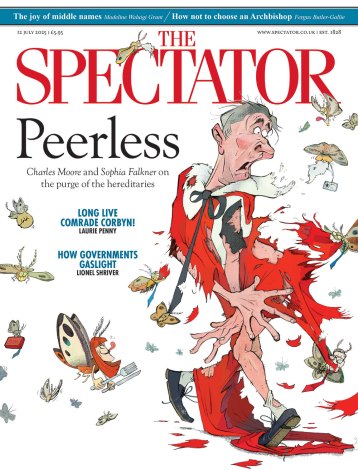Horror films weren’t called horror films until the 1930s — when critics applied that label to Universal’s Dracula (1931) and Frankenstein (1931) — but the seeds of the genre were already sprouting in the silent era. In fact, these early scary films set the template for modern horror, from the expressionist shadows of German films such as Nosferatu (1922) and The Cabinet of Dr Caligari (1920), to the theatrical grotesques played by Lon ‘Man of a Thousand Faces’ Chaney in Hollywood.
You’ll find silent adaptations not just of Dracula, but Frankenstein, Dr Jekyll and Mr Hyde, folk legends and the stories of Edgar Allen Poe; vampires, golems, witches, demons and ghosts. What’s wonderful is that, because these movies aren’t self-consciously sticking to a set of genre conventions, they’re often enjoyably, terrifyingly strange.
With Halloween upon us tomorrow — and bearing in mind my Spectator colleagues’ spooky recommendations from previous years, here and here — here is my pick of five silent horrors that may be new to you.
There is too much here to watch before bedtime, so you may just have to stay up beyond the witching hour…
Le Manoir du Diable (George Méliès, 1896)
Just one year after the Lumiére brothers’ first cinématographe show, and one year before the publication of Bram Stoker’s Dracula, the French master of trick cinema created what is thought to be the world’s first horror film. To be truthful, it’s more of a comedy-horror. A bat flies through an empty castle, and is transformed into a devil, who over the following three minutes causes all kinds of spooky mayhem, conjuring up skeletons, spell books, ghosts and witches. It’s all accomplished at high speed and with a great sense of humour, via Méliès’s trademark jump-cuts and stage pyrotechnics. It’s a pantomime, but it may still make you jump. What’s that behind you?
Suspense (Lois Weber, 1913)
The title says it all. A woman is alone in a deserted ‘lonesome’ house with her baby and there’s a strange man prowling around outside. Suddenly, he’s inside the house, and he has a knife…
It’s a simple story (watch it in the video at the top of this post), but it is told with great efficiency and plenty of shocks. Triple split screens tell us how close the intruder is, and how far away the woman’s husband is; overhead angles show the villain’s leer from her point of view; and the film climaxes with a brilliantly nervy chase sequence. Not least among Suspense’s achievements is that it neatly condenses the plot of many a slasher flick to come into ten tense minutes. A year later, Weber made The Merchant of Venice (1914) and so became the first female director to shoot a feature-length film.
Häxan (Benjamin Christensen, 1922)
Documentaries don’t feature in lists of horror films very often, but this hugely expensive Swedish/Danish co-production is an unusual beast. Posing as a serious-minded study of witchcraft, superstition and mental illness from the medieval era to the 20th century, Häxan is enlivened by dramatic sequences — some of them containing graphic violence and nudity — featuring the occult antics of witches, devils and sorcerers. Censors around the globe went to town on the film, but it was a smash hit nevertheless, proving that audiences love to be scared at the cinema, even if it is under the guise of a historical lecture.
Häxan does attempt to make a serious point in its conclusion: that what we now understand to be psychological disorders were once misread as demonic possession (illustrated by scenes of nuns subject to ‘contagious insanity’, reminiscent of Ken Russell’s much later, and highly controversial, 1971 film The Devils). It’s not the message will give you nightmares, though, but the film’s gruesome imagery, including the director himself as a horned, claw-fingered and semi-naked Satan
Faust: Eine deutsche Volkssage (FW Murnau, 1926)
F.W. Murnau had mastered the art of terror, and expressionism, in his earlier Nosferatu, but in Faust he found a story with a scope as vast as his imagination. Emil Jannings puts in a performance that is at once hilarious and repulsive as Mephisto, who persuades Dr Faust (Gösta Ekman, both as the old and young man) to exchange his soul for a cure for the plague. The epidemic shown as clouds of black smoke choking the town; its casualties are carried through the streets by an endless stream of white-draped stretcher-bearers.
Even at it is most horrible, this film is staggeringly beautiful. Effects-heavy sequences, such as the cloak ride and Faust’s summoning of the devil, are so rich in detail, and so innovatively shot, that you’ll understand why the good doctor was seduced into signing the fatal contract in the first place. The bleak final scenes will live with you long after you watch.
La Chute de la Maison Usher (Jean Epstein, 1928)
A late-period silent by a French director known for his poetic, impressionist style, in collaboration with the surrealist Luis Bunuel, La Chute de la Maison Usher is a chilling glimpse of a disturbed world. Jean Epstein merged two Edgar Allen Poe stories to make this film: The Fall of the House of Usher is here wrapped around The Oval Portrait.
Roderick Usher (Jean Debucourt) lives in splendid isolation with his ailing wife, Madeleine (Marguerite Gance, who was married to Abel Gance). The final branch in a twisted family tree, Usher is cursed with madness, or ‘degeneracy’, and his only passion is to work obsessively on a portrait of his wife. But, as the portrait becomes more vivid, Madeleine fades. When she dies, Usher loses all grip on his fragile sanity, and both his psyche and his physical surroundings are ripped to fragments. Madeleine (or her ghost) appears, each string on his guitar snaps one by one, there’s a fire… It’s not an easy film to watch, nor is it always easy to follow, but your spine will definitely tingle.





Comments